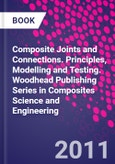Part one discusses bolted joints whilst part two examines bonded joints. Chapters review reinforcement techniques and applications for composite bolted and bonded joints and investigate the causes and effects of fatigue and stress on both types of joint in various applications and environments. Topics in part one include metal hybridization, glass-reinforced aluminium (GLARE), hybrid fibre metal laminates (FML), glass fibre reinforced polymer (GFRP) and carbon fibre reinforced polymer (CFRP) composites. Topics in part two include calculation of strain energy release rates, simulating fracture and fatigue failure using cohesive zone models, marine and aerospace applications, advanced modelling, stress analysis of bonded patches and scarf repairs.
Composite joints and connections is a valuable reference for composite manufacturers and composite component fabricators, the aerospace, automotive, shipbuilding and civil engineering industries and for anyone involved in the joining and repair of composite structures.
Table of Contents
Contributor contact details
Introduction
Part I: Bolted joints
Chapter 1: Reinforcement of composite bolted joints by means of local metal hybridization
Abstract:
1.1 Introduction
1.2 Local hybridization concept
1.3 Reinforcement materials
1.4 Bearing strength
1.5 Conclusions
Chapter 2: Bolted joints in glass reinforced aluminium (Glare) and other hybrid fibre metal laminates (FML)
Abstract:
2.1 Introduction
2.2 Glare and the fibre metal laminate (FML) concept
2.3 Loads in a mechanically fastened FML joint
2.4 Static behaviour of FML joints
2.5 Fatigue behaviour of FML joints
2.6 Residual strength of FML joints
2.7 Sources of further information and advice
Chapter 3: Bolted joints in pultruded glass fibre reinforced polymer (GFRP) composites
Abstract:
3.1 Introduction
3.2 Experimental characterisation of stiffness and strength of bolted joints
3.3 Tests on tension joints
3.4 Analysis of stresses, deformations and bolt load-sharing in tension joints
3.5 Design guidance for tension joints
3.6 Research needs and future prospects
Chapter 4: Bolt-hole clearance effects in composite joints
Abstract:
4.1 Introduction
4.2 Single-bolt joints
4.3 Multi-bolt joints
4.4 Conclusions
Chapter 5: Stress analysis of bolted composite joints under multiaxial loading
Abstract:
5.1 Introduction
5.2 Bolt load distribution
5.3 Numerical results
5.4 Conclusions
Chapter 6: Strength prediction of bolted joints in carbon fibre reinforced polymer (CFRP) composites
Abstract:
6.1 Introduction
6.2 Observed failure mechanisms
6.3 Physically based failure modelling
6.4 Strength analysis at the coupon level
6.5 Dealing with the component level
6.6 Conclusion and future trends
6.7 Acknowledgement
Chapter 7: Fatigue of bolted composite joints
Abstract:
7.1 Introduction
7.2 Coefficient of friction
7.3 Clamping force
7.4 Hole wear
7.5 Fastener failure
7.6 Shear-out
7.7 Net-section failure
7.8 Joint design
Chapter 8: Influence of dynamic loading on fastened composite joints
Abstract:
8.1 Introduction and background
8.2 Test methods
8.3 Single fastener testing
8.4 Multiple fastener testing
8.5 Simulation methods
8.6 Future trends
8.7 Conclusion
8.8 Acknowledgements
Chapter 9: Effects of temperature on the response of composite bolted joints
Abstract:
9.1 Introduction
9.2 Effects of temperature on strength
9.3 Damage evolution
9.4 Analytical works
9.5 Conclusions
9.6 Acknowledgements
Part II: Bonded joints
Chapter 10: Calculation of strain energy release rates for bonded joints with a prescribed crack
Abstract:
10.1 Introduction
10.2 Strain energy release rate
10.3 Calculating strain energy release rate using finite element methods
10.4 Calculating strain energy release rate using an analytical approach
Chapter 11: Simulating fracture in bonded composite joints using cohesive zone models
Abstract:
11.1 Introduction
11.2 Implementation of a potential-based cohesive model in ABAQUS Standard framework
11.3 Analysis of debonding in AA6082T6/epoxy T-peel joints
11.4 Conclusions and future trends
Chapter 12: Simulating fatigue failure in bonded composite joints using a modified cohesive zone model
Abstract:
12.1 Introduction to the simulation of fatigue in bonded joints
12.2 Simulation of fatigue crack growth with the cohesive zone model: basic concept and literature works
12.3 Development of a two-dimensional cohesive zone model for the prediction of the fatigue crack growth under mode I loading
12.4 Two-dimensional cohesive zone model for the prediction of fatigue crack growth under mixed mode I/II loading
12.5 Simulation of fatigue crack growth with crack length jumps due to static overloads
12.6 Conclusions
Chapter 13: Strength of bonded overlap composite joints in marine applications
Abstract:
13.1 Introduction
13.2 Design recommendations
13.3 Experimental studies on strength of adhesively bonded joints
13.4 General description of the response of bonded overlap joints to mechanical loads
13.5 Strength of materials approaches
13.6 Fracture mechanics approaches
13.7 Discussion, conclusions and future trends
13.8 Acknowledgements
Chapter 14: Advanced modeling of the behavior of bonded composite joints in aerospace applications
Abstract:
14.1 Introduction
14.2 Bonded joints
14.3 Cohesive zone model (CZM) based bonded joint analysis
14.4 Design perspective
Chapter 15: Mixed mode energy release rates for bonded composite joints
Abstract:
15.1 Introduction
15.2 Basic formulae of mixed mode energy release rates
15.3 Parametric case studies
15.4 Comparison with FEA results
15.5 Experimental validation
15.6 Conclusions
15.7 Acknowledgements
Chapter 16: Stress analysis of bonded patch and scarf repairs in composite structures
Abstract:
16.1 Introduction
16.2 Scarf joint and repair descriptions
16.3 Methodology
16.4 Numerical results
16.5 Conclusions
Chapter 17: High strain rate behaviour of bonded composite joints
Abstract:
17.1 Introduction
17.2 Typical rubber-modified epoxy adhesive performance
17.3 Dynamic joint failure
17.4 Testing and analysis of mixed and mode II specimens
17.5 Testing and analysis of scarf joint failure
17.6 Conclusion
17.7 Acknowledgements
Index








